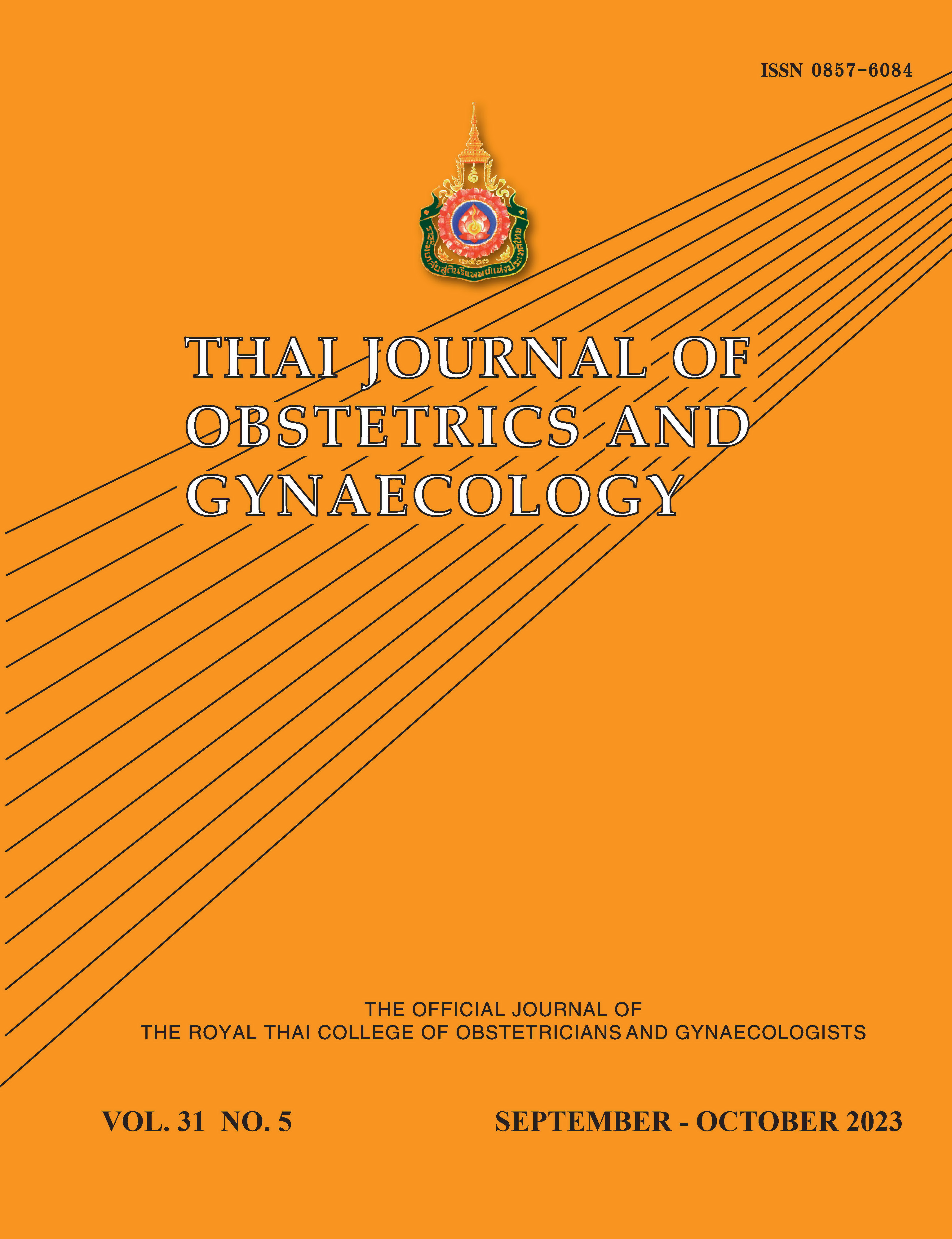Prevalence of Appendiceal Pathology in Ovarian Cancer When Appendectomy is performed during Surgical Treatment
Main Article Content
Abstract
Objectives: Pathological appendectomy findings during the surgical staging procedure for ovarian cancer can determine the extent of the cancer, and specific treatment depends on whether a primary appendiceal malignancy or an ovarian metastasis is involved. This study aimed to evaluate appendiceal histology from comprehensive surgery for epithelium ovarian cancer.
Materials and Methods: We retrospectively evaluated patients who underwent cytoreductive surgery for primary and secondary epithelium ovarian cancer and who had undergone an appendectomy between 2003 and 2016. The clinicopathologic findings concerning ovarian cancer and the appendix, and risk factors for appendiceal abnormalities were presented.
Results: Of 340 patients with ovarian cancers, 322 (94.7%) were diagnosed with primary epithelium ovarian cancer and 60.6% were at an early stage. Mucinous carcinoma was the most common in histology (40%). Appendiceal malignancies were identified in 53 (15.6%) patients, of whom 42 (12.4%) had secondary metastasis from ovarian cancer, and two patients had stomach or breast metastases. Primary appendiceal neoplasms were identified in nine patients, with three patients presenting with synchronous ovarian cancers. A grossly abnormal appendix (odds ratio [OR] 27.6, 95% confidence interval [CI] 7.1–107.3, p < 0.001), advanced stage ovarian cancer (OR 114.6, 95%CI 14.6-99.4, p < 0.001), and secondary ovarian cancer (OR 86.7, 95%CI 8.5-887.7, p < 0.001) were associated with appendiceal neoplasm in multiple logistic regression analysis.
Conclusion: Appendiceal neoplasm accompanied a significant number of ovarian cancers. Appendectomy is recommended as part of surgical staging in abnormal looking appendices, advanced ovarian cancer, and secondary ovarian cancer.
Article Details

This work is licensed under a Creative Commons Attribution-NonCommercial-NoDerivatives 4.0 International License.
References
Berek JS, Crum C, Friedlander M. Cancer of the ovary, fallopian tube, and peritoneum. Int J Gynecol Obstet 2015;131:S111–22.
Morgan RJ, Armstrong DK, Alvarez RD, Bakkum-Gamez JN, Behbakht K, Chen LM, et al. Ovarian Cancer, Version 1.2016, NCCN Clinical Practice Guidelines in Oncology. J Natl Compr Canc Netw 2016;14:1134–63.
Ayhan A, Gultekin M, Taskiran C, Salman MC, Celik NY, Yuce K, et al. Routine appendectomy in epithelial ovarian carcinoma: is it necessary? Obstet Gynecol 2005;105:719–24.
Cibula D, Verheijen R, Lopes A, Dusek L, ESGO Council. Current clinical practice in cytoreductive surgery for advanced ovarian cancer: a European survey. Int J Gynecol Cancer 2011;21:1219–24.
Giri S, Lal P, Rawal S, Sekhon R. Routine appendicectomy be performed as a part of surgical staging in ovarian cancer. Int J Reprod Contracept Obstet Gynecol 2016;5:4263–5.
Beşe T, Kösebay D, Kaleli S, Oz AU, Demirkiran F, Gezer A. Appendectomy in the surgical staging of ovarian carcinoma. Int J Gynaecol Obstet 1996;53:249–52.
Ramirez PT, Slomovitz BM, McQuinn L, Levenback C, Coleman RL. Role of appendectomy at the time of primary surgery in patients with early-stage ovarian cancer. Gynecol Oncol 2006;103:888–90.
Kurman RJ, Carcangiu ML, Herrington CS, Young RH. WHO classification of tumours of female reproductive organs. 4th ed. Lyon, IARC Press: 2014;12-14.
Prat J, Figo Committee on Gynecologic Oncology. Staging classification for cancer of the ovary, fallopian tube, and peritoneum. Int J Gynaecol Obstet 2014;124:1–5.
Hamilton SR, Aaltonen LA. WHO classification of tumours. Pathology and genetics of tumours of the digestive system. Lyon, IARC Press: 2000; 94.
McCluggage WG, Wilkinson N. Metastatic neoplasms involving the ovary: a review with an emphasis on morphological and immunohistochemical features. Histopathology 2005;47:231–47.
McCluggage WG. Morphological subtypes of ovarian carcinoma: a review with emphasis on new developments and pathogenesis. Pathology 2011;43:420–32.
Rouzbahman M, Chetty R. Mucinous tumours of appendix and ovary: an overview and evaluation of current practice. J Clin Pathol 2014;67:193–7.
Timofeev J, Galgano MT, Stoler MH, Lachance JA, Modesitt SC, Jazaeri AA. Appendiceal pathology at the time of oophorectomy for ovarian neoplasms. Obstet Gynecol 2010;116:1348–53.
Wong LF, Wahab NA, Gleeson N. Appendectomy with cytoreductive surgery for ovarian and type 2 endometrial carcinoma. Eur J Gynaecol Oncol 2014;35:143–8
Cheng A, Li M, Kanis MJ, Xu Y, Zhang Q, Cui B, et al. Is it necessary to perform routine appendectomy for mucinous ovarian neoplasm? A retrospective study and meta-analysis. Gynecol Oncol 2017;144:215–22.
Feigenberg T, Covens A, Ghorab Z, Ismiil N, Dubé V, Saad RS, et al. Is routine appendectomy at the time of primary surgery for mucinous ovarian neoplasms beneficial? Int J Gynecol Cancer 2013;23:1205–9.
Kokanali MK, Guzel AI, Erkilinc S, Tokmak A, Topcu HO, Gungor T. Risk factors for appendiceal metastasis with epithelial ovarian cancer. Asian Pac J Cancer Prev 2014;15:2689–92.
Al-Temimi M, Trujillo C, Agapian J, Park H, Dehal A, Johna S, et al. Does incidental appendectomy increase the risk of complications after abdominal procedures? Am Surg 2016;82:885–9.


